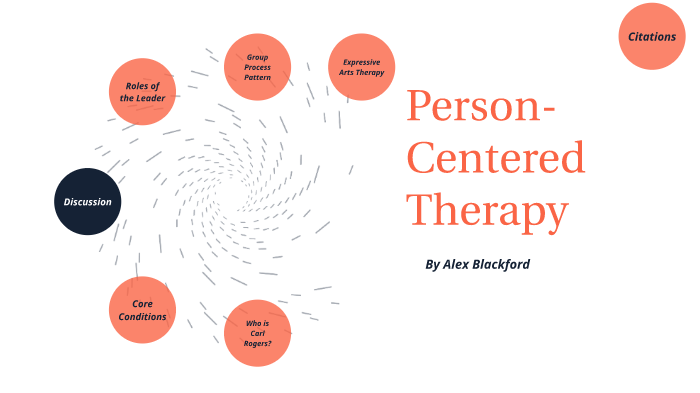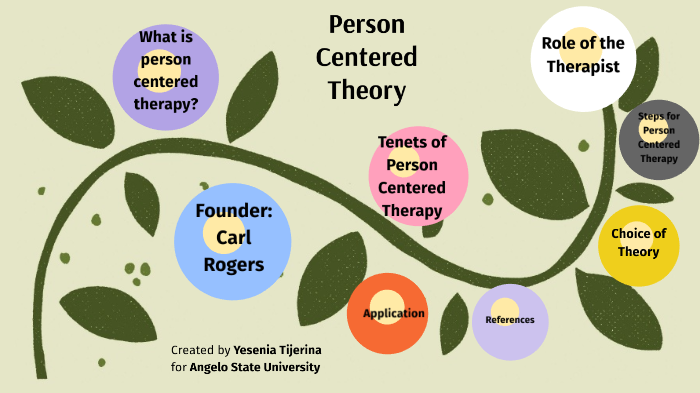Carl Rogers' client-centered therapy, also known as person-centered therapy, is a form of psychotherapy that places the needs and feelings of the client at the center of the therapeutic process. It is based on the belief that individuals have the capacity for self-direction and personal growth, and that the therapist's role is to provide a supportive and accepting environment in which the client can explore their thoughts, feelings, and behaviors.
One of the key principles of client-centered therapy is empathy, which refers to the therapist's ability to understand and share the perspective of the client. This involves being fully present with the client and actively listening to their experiences and feelings without judgment. The therapist does not try to impose their own views or solve the client's problems, but rather helps the client to discover their own inner resources and find their own solutions to their issues.
Another important aspect of client-centered therapy is congruence, which refers to the therapist's authenticity and genuineness in the therapeutic relationship. This means being transparent and open with the client, and showing them acceptance and understanding even if they express difficult or uncomfortable thoughts or feelings. The therapist strives to create a safe and non-threatening environment in which the client feels free to be themselves and explore their emotions.
In addition to empathy and congruence, client-centered therapy also emphasizes unconditional positive regard, which is the therapist's acceptance and support of the client as a person, regardless of their thoughts, feelings, or behaviors. This helps the client to feel valued and accepted, which can be particularly important for those who have experienced rejection or criticism in the past.
Client-centered therapy can be an effective treatment for a wide range of mental health issues, including depression, anxiety, and trauma. It has been found to be particularly helpful for individuals who may feel stuck in negative patterns of thought or behavior, and who may benefit from the opportunity to explore their feelings and emotions in a supportive and accepting environment.
Overall, Rogers' client-centered therapy is a highly effective and compassionate form of psychotherapy that empowers individuals to take control of their own healing and personal growth. By providing a safe and supportive space for exploration and self-discovery, it can help clients to better understand themselves and make positive changes in their lives.
Rogers Client

This self-direction plays a vital part in client-centered therapy. We would literally not know what anything was. He was trained in clinical psychology at Columbia University in the 1920s when the field was in its infancy. With these client-centred therapy techniques, clients can better understand how their actions affect them, which helps them take responsibility for their actions. This may mean disclosing things about yourself — not necessarily facts, but feelings as well. Importantly, the essential components of therapy that Rogers put forward empathy, congruence, and unconditional positive regard can be employed by any therapist, regardless of their specific approach to therapy. Client, or person centred counselling is commonly used to treat a number of issues which include relationship problems, depression, anxiety, bereavement, addictions, sexuality, anger and transitions in life.
Who is the father of person centered therapy?

In an environment conducive to growth, each person has the potential to be the best they can be. ~~~ The 7 Habits of Highly Effective People: Restoring the character ethic. Rogers 1961 rejected the deterministic nature of both Believing strongly that theory should come out of practice rather than the other way round, Rogers developed his theory based on his work with emotionally troubled people and claimed that we have a remarkable capacity for self-healing and personal growth leading towards Rogers noticed that people tend to describe their current experiences by referring to themselves in some way, for example, "I don't understand what's happening" or "I feel different to how I used to feel". A therapist may be in a difficult family situation. Central to Rogers' 1959 theory is the notion of self or Consequently, the self-concept is a central component of our total experience and influences both our perception of the world and perception of oneself. If there are any techniques they are listening, accepting, understanding and sharing, which seem more attitude-orientated than skills-orientated.
Person Centred Therapy

What is the importance of using person-centered planning for curriculum development? That is, how we measure our worth ultimately depends on the conditions placed by others. We are social beings from first to last. The organism: A holistic approach to biology derived from pathological data in man. What is Rogers self theory? Leta Stetter Hollingworth: Psychologist, educator, feminist. When did Carl Rogers create client-centered therapy? This also allows them to evaluate their subjective experiences and determine whether they help them towards self-actualisation and break the barriers. Conditions of worth, according to Rogers, can also hinder self-actualisation, which happens when imposed conditions from significant others, such as parents, become the basis of our regard for ourselves. The Rogerian fully functioning person: A positive psychology perspective.







